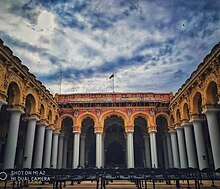Thirumalai Nayakkar Mahal
| Mannar Thirumalai Nayakkar Mahal | |
|---|---|
Madurai | |
| Owner | Archaeological Survey of India, Government of Tamil Nadu |
| Dimensions | |
| Other dimensions | 900 ft × 660 ft (270 m × 200 m) (length x width) |
| Technical details | |
| Size | 554,000 sq ft (51,500 m2) |
| Design and construction | |
| Engineer | Unknown |
Thirumalai Nayak Palace is a 17th-century palace erected in 1636 by King
History

The Nayaks of Madurai ruled this Kingdom from 1545 until the 1740s and
Design and construction
Built in 1636, as a focal point of his capital at
Local legend goes that the king hired an Italian architect to design the complex, and hence some qualify it as of Dravidian – Italian architecture. During this period Madurai was a thriving kingdom with Portuguese, Dutch and other Europeans as traders, missionaries and visiting travelers. This might have influenced the design inspirations of the palace.[3] Many Tamil Nadu government agencies also qualify the architecture of Thirumalai Nayaka Palace as of Indo-Saracenic architecture or of Dravidian architecture.[4][5]
Art historians however consider this palace to be an outstanding example of Vijayanagara architecture in its late Nayaka style.[1][6][7] Some of them evoke the origin of theories on the possible intervention of European architects and craftsmen, or of a major Western artistic influence, as motivated by a priori and colonial prejudices.[1]
During the 18th century, many structures that were part of this palace were pulled down or incorporated into buildings in the adjacent streets. What remains is the enclosed court known as the Svarga Vilasam and a few adjoining buildings. The audience chamber of the Svarga Vilasam is a vast hall with arcades about 12 m high. The court yard of Svarga Vilasam measures 75 m (246 ft) by 50 m (160 ft).[8] The architecture is a blend of indigenous and Islamic forms. Thirumalai nayakar mahal is famous for its giant pillars. Pillar's height is 82 feet (25 m) and width is 19 feet (5.8 m). Historically, the palace measured 554,000 sq ft (51,500 m2) and was 900 ft (270 m) long by 660 ft (200 m) wide.
Courtyard

Upon entering into the gates of the palace, there is a central courtyard measuring 3,700 m2 (40,000 sq ft). The courtyard is surrounded by massive circular pillars and has a circular garden.

Interior

The palace was divided into two major parts, namely Swarga Vilasam (Celestial Pavilion) and Ranga Vilasam. The royal residence,
Materials used
The structure was constructed using foliated brickwork and the surface details and finish in exquisite stucco called chunnam using chunnam (shell lime) and mixed with egg white to obtain a smooth and glossy texture. The steps leading up to the hall were formerly flanked by two equestrian statues of excellent workmanship.
The pillars supporting the arches are 13 metres (43 ft) tall and are again joined by foliated brickwork that carries a valance and an entablature rising up to a height of 20 metres (66 ft). The decoration is done, (shell lime). The pavilions topped with finials that were covered with gold are on either side of the courtyard.
Popular culture

After independence, the Thirumalai Palace was declared as a national
References
- ^ OCLC 53319398.
- ^ "Welcome to Madurai - Tourism". Archived from the original on 22 April 2012. Retrieved 26 July 2013.
- ^ Abraham, Sharon (26 July 2021). "Thirumalai Nayakar Mahal: The story of south India's most stunning palace". Mittai Stories. Retrieved 6 September 2021.
- ^ Doe, John. "Thirumalai Nayakar Mahal | Tamil Nadu Tourism". Tamilnadu Tourism. Retrieved 25 April 2023.
- ^ "Thirumalai Nayak Palace | Madurai District, Government of Tamilnadu | India". Retrieved 25 April 2023.
- )
- OCLC 31012650.
- ^ ISBN 978-81-87952-12-1.
- ISBN 978-81-88661-42-8.
